This document describes a new project called Riot Art that aims to create original theatre pieces to unite the educational community through artistic expression of current issues in higher education. It discusses how Riot Art takes inspiration from political theatre movements of the past and aims to facilitate understanding between students, staff, and government through workshops and performances. The workshops will use techniques from Theatre of the Oppressed to explore issues, define problems, and find multiple solutions through enactment and role-playing. The goal is to challenge conformity and foster democratic dialogue using aesthetic experience and performance.


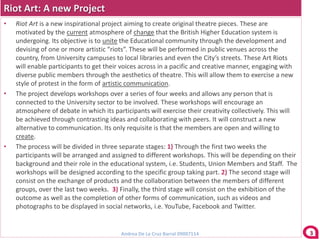

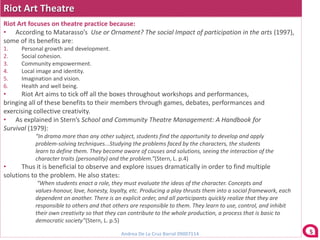

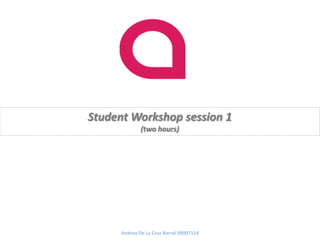

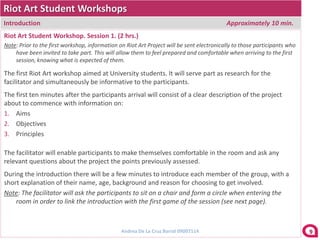
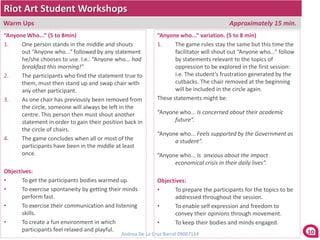
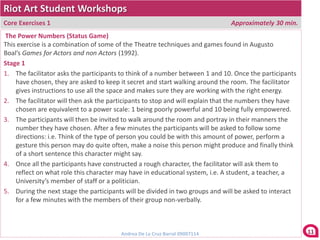
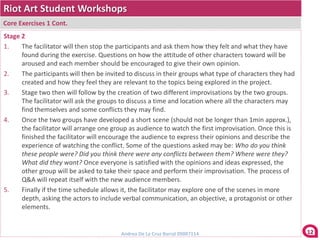


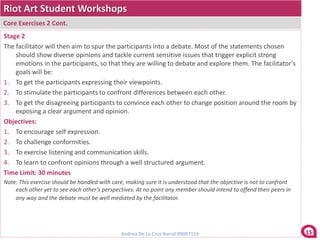
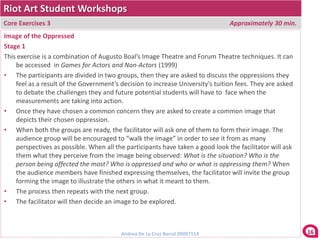
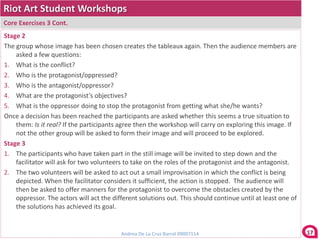

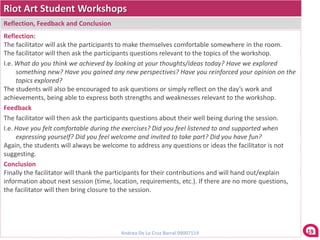
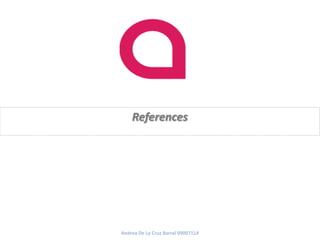
![References
• Clark, L. (2010). University cuts mean students pay more for less. [Online]. August 2010. Available
from: http://www.thisismoney.co.uk/savings-and-banking/student-
finance/article.html?in_article_id=511926&in_page_id=52 [Accessed 30th November, 2010]
• RSA Animates. (2010). Changing Education Paradigms. [Online Video]. October 14th. Available
from: http://www.youtube.com/watch?v=zDZFcDGpL4U [Accessed: November 2010]
• Stern, L. (1979). School and Community Theatre Management. A Handbook for Survival.
Massachusetts: Allyn and Bacon Inc.
• Matarasso, F. (1997). Use or Ornament? The Social Impact of Participation in the Arts. [Online]
2003. Available from:
http://web.me.com/matarasso/one/research/Entries/2009/2/19_Use_or_Ornament_files/Use%2
0or%20Ornament.pdf [Accessed 30th November, 2010]
• Pitcher, M. (1990). What is The Theatre of The Oppressed. [Online]. January 1990. Available from:
http://www.toplab.org/whatis.htm [Accessed 30th November, 2010]
• Barnett, R. (2010). Higher Fees: The Case For and Against. [Online]. November 24th. Available
from: http://news.sky.com/skynews/Home/Politics/University-Fees-Explained-The-Case-For-And-
Against-Putting-Tuition-Fees-
Up/Article/201011415827330?lpos=Politics_First_Politics_Feature_Teaser_Region__0&lid=ARTICL
E_15827330_University_Fees_Explained%3A_The_Case_For_And_Against_Putting_Tuition_Fees_
Up [Accessed: 30th November 2010]
Andrea De La Cruz Barral 09007114 21](https://image.slidesharecdn.com/riotartfinal-copy-111113170830-phpapp02/85/Riot-art-final-copy-21-320.jpg)
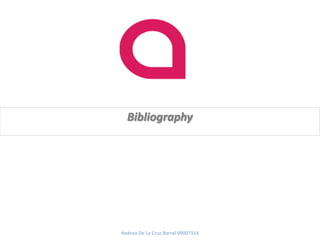
![Bibliography
• Boal, A. (1992). Games for Actors and Non-Actors. Second Edition (2002). Oxon: Routeledge.
• Boal, A. (1979). Theatre of the Oppressed. Third Edition (2008). London: Pluto Press.
• Johnston, K. (1981). Impro. London: Methuen Drama.
• Matarasso, F. (1997). Use or Ornament? The Social Impact of Participation in the Arts. [Online]
2003. Available from:
http://web.me.com/matarasso/one/research/Entries/2009/2/19_Use_or_Ornament_files/Use%2
0or%20Ornament.pdf [Accessed 30th November, 2010]
• Neelands, J. & Goode, T. (1990). Structuring Drama Work. Second Edition (2000). Cambridge:
Cambridge University Press.
• Robinson, K. (2009). The Element: How Finding Your Passion Changes Everything. London:
Penguin Books.
• Stern, L. (1979). School and Community Theatre Management. A Handbook for Survival.
Massachusetts: Allyn and Bacon Inc.
• Van Erven, E. (2001). Community Theatre Global Perspectives. London: Routeledge.
Andrea De La Cruz Barral 09007114 23](https://image.slidesharecdn.com/riotartfinal-copy-111113170830-phpapp02/85/Riot-art-final-copy-23-320.jpg)